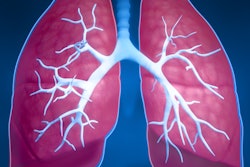
A low-cost metabolic test that uses MR spectroscopy to analyze blood and tissue samples may complement the early detection of lung cancer and help clinicians identify individuals who would benefit most from CT lung screening, according to an article published online July 16 in Scientific Reports.
Several large-scale clinical trials have demonstrated the potential benefits of CT lung screening in the early detection of cancer. Nonetheless, recommendations from the U.S. Preventive Services Task Force (USPSTF) reserve the test for smokers who meet a strict set of age and smoking history criteria.
Currently, no standardized screening tool exists for identifying early instances of lung cancer among individuals who fall outside established guidelines. As a result, the vast majority of individuals who present to the hospital with symptoms of lung cancer already harbor locally advanced or metastatic disease, noted co-principal investigators Dr. David Christiani and Leo Cheng, PhD, from Massachusetts General Hospital.
As such, the researchers sought out a more accessible alternative to CT lung screening geared toward the general public. They explored the possibility of relying on metabolic biomarkers to develop a low-cost, minimally invasive method to spot individuals who would likely gain from a referral for CT lung screening.
In the proof-of-concept study, Christiani, Cheng, and colleagues obtained specimens from 93 patients who underwent surgery for lung cancer, with an additional 29 samples from healthy individuals to serve as the control. Roughly 62% of the patients had stage I lung cancer at the time of surgical treatment.
The group developed a technique using high-resolution MR spectroscopy to quantify the data from these tissue and blood samples. An analysis of the data uncovered metabolic profiles -- consisting of varying levels of amino acids and other organic molecules -- that had statistically significant associations with the presence of lung cancer. The researchers also identified profiles that were particular to distinct types of lung cancer (e.g., small cell carcinoma and adenocarcinoma) requiring different treatments, as well as to varying stages of disease.
What's more, the tests were able to distinguish between samples that came from patients who had short-term survival (3.4 years or fewer) after surgery and those who lived longer than 3.4 years. With further validation, the ability to differentiate between these two groups could help clinicians pinpoint individuals at especially high risk of lung cancer mortality in the earliest phases of case management, the researchers noted.
For example, lung cancer patients consistently had specific amounts of lactate, glutamate, and glycerophosphocholine in their blood that differentiated them from healthy individuals. In addition, patients with a longer survival period had elevated levels of certain amino acids such as glutamine but depressed levels of glutamate, compared with the other patients.
"Our proof-of-concept MR spectroscopy exploratory study of paired human lung cancer tissue and serum samples demonstrates the potential of a physical chemistry approach for the discovery of human serum lung cancer metabolomic markers," Christiani, Cheng, and colleagues wrote.
This work lays the foundation for using a blood test that could be included as part of a standard physical to predict whether an individual has signs pointing to lung cancer and should be referred for CT lung screening, the authors noted.
"Success in these investigations can propel biomarkers towards clinical trials and towards the ultimate goal -- to indicate cancer and screen patients to advanced radiological imaging when warranted," they concluded.



















